By Dr Adriana James | NLP Master Trainer | Tad James Co.
What if you could tell when someone is confused, disengaged, or emotionally uncomfortable—without them saying a word?
You can. But it takes more than intuition.
In Neuro-Linguistic Programming (NLP), we call this skill sensory acuity — and it’s one of the most practical tools for communication mastery.
In this article, Dr. Adriana James builds on our previous exploration of skin color shifts, diving deeper into skin tone, facial symmetry, and breathing patterns—three overlooked yet powerful signals that reveal a person’s emotional state and inner experience.
These micro-signals can tell you more than words ever could — if you know how to observe them properly.
Why Micro-Observations Matter More Than Words
Have you ever been in a conversation where someone smiled, nodded, and said all the right things—but something felt off?
That “off” feeling isn’t magic. It’s your unconscious mind picking up subtle changes—in muscle tone, breath, or facial balance—that contradict the words being spoken.
In NLP, we don’t just notice those cues. We learn to interpret them with precision and context.
That’s what makes the difference between guessing and knowing.
And when used skillfully, this awareness can strengthen rapport, prevent miscommunication, and uncover resistance early.
What To Observe Next: Sensory Acuity, Part II
1. Skin Tone (Muscle Tension Beneath The Surface)
This isn’t about complexion. It’s about noticing the tone of the skin — tight vs. relaxed as it reflects what’s happening internally.
- A tense face may indicate alertness, discomfort or emotional stress.
- A relaxed face generally signals ease, openness or trust.
Context is everything. The power lies in comparison.
Observe someone’s baseline when they’re calm or neutral, then notice how tone changes in response to different topics or questions.
Pro tip: Watch how light reflects off the face. Tense muscles reflect light differently. A sudden “shine” or increased brightness can indicate internal tension — even beneath makeup.
Think of it as visual biofeedback — what’s happening inside often shows up first on the surface.
2. Facial Symmetry (Or Sudden Asymmetry)
While no one’s face is perfectly symmetrical, sudden or momentary asymmetry can reveal a shift in state.
Look for:
- One eyebrow lifting noticeably higher
- A corner of the mouth tensing or drooping
- One cheek pulling back or tightening during a topic change
These subtle cues often occur without conscious control. To interpret them effectively, take a mental snapshot of someone’s “neutral” state, then observe what changes under different emotional or conversational conditions.
Over time, you’ll build your own internal reference points for what’s ‘normal’ and what signals a shift.
3. Breathing Patterns (The Ultimate Emotional Cue)
Breath is one of the most unconscious behaviors we have, and also one of the most revealing
Start paying attention to:
- Rate: Are they breathing faster, slower, or suddenly held?
- Location: Are they breathing from the chest, midsection or lower belly?
- Rhythm: Is the breath smooth, shallow, choppy, erratic?
Each state of being — relaxation, anxiety, confidence, discomfort — has a breathing pattern attached to it.
Unlike smiles or posture, breath is far more difficult to control in casual conversation. That’s why it’s such a reliable tell.
Try this: Place one hand on your chest and one on your belly. Notice where your breath originates. Now imagine observing this in someone else — with your eyes only. That’s part of what you’ll develop in NLP training.
This alone can change how you coach, sell, lead, or support others.
This Isn’t Just “Body Language Lite”
While mainstream body language focuses on generalised signs (“arms crossed = defensive”), NLP sensory acuity is far more individualised and dynamic.
We don’t teach you to memorise symbols.
We train you to observe real-time, context-based changes — and then match those patterns to thought, language and behavioural shifts.
It’s not about guessing.
It’s about calibration — noticing what changes, when, and why.
It’s personalised, not prescriptive. And it’s far more accurate.
How to Practise This Today
Dr. Adriana James recommends starting small:
-
- Spend 1–2 days simply observing skin tone and facial symmetry in people around you
- Spend another 2–3 days watching breath — especially in moments of decision-making, tension or storytelling
- Don’t rush to assign meaning. First, notice the pattern of change
When you practise this, you begin to see beneath the surface.
You no longer rely on guesswork, intuition, or assumptions — you read signals with purpose and precision.
Want to Master This Skill Professionally?
This is just the beginning of what you’ll learn inside our NLP Practitioner and Master Practitioner Training, where we work hands-on with students to build advanced sensory acuity and interpersonal awareness.
You’ll be able to:
✅ Detect when a client is holding back — without them saying a word
✅ Identify confusion before it becomes resistance
✅ Understand how emotional states show up physically
✅ Respond to unspoken signals with clarity and confidence
Reserve your spot in NLP Practitioner Training »
Advance into Master Practitioner Training »
You don’t need to read minds — just the signals most people miss.

